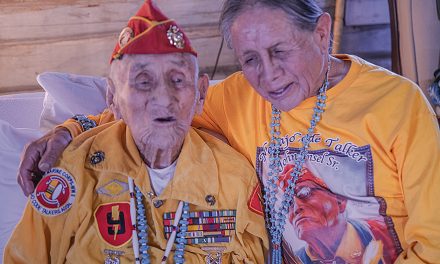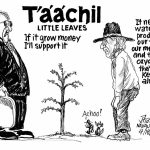
50 Years Ago: Tribe reignites feud with DNA
Just when everyone thought the feud between the members of the Navajo Tribal Council and the reservation’s legal aid service had died down, the tribe found a new way to activate it.
The Council, in a special meeting, approved a resolution by a vote of 33-28, to request that it supervise funding for DNA-People’s Legal Services instead of coming directly to the program from the U.S. Office of Economic Opportunity. The debate on the matter by Council on that day was probably the most contentious in years.
Realizing the vote would be controversial, Navajo Tribal Chairman Raymond Nakai decided to chair the session himself instead of turning it over to the vice chairman, Nelson Damon, who usually is the presiding officer. And, for the first time in years, the vote was done by a roll call instead of asking delegates to raise their hands. Four members of the Council abstained from voting and 11 members decided it was too much of a political risk to even attend the session.
The debate lasted for three days with a lot of yelling and even a little name-calling. The Council Chamber was packed with DNA employees and supporters of the program. Tribal police were also on site in case the audience became unruly.
As explained by the Navajo Times in a story that week that took up more than half the front page, DNA and the tribe had been at odds for more than a year. Some of it was because of Ted Mitchell, the former director of the agency who had recently stepped down to be a staff attorney, hoping that would calm the situation.
It did for a while, but it flared up when Nakai started using his opposition to DNA in his campaign speeches, arguing that the agency was damaging tribal sovereignty.
The Council action would not affect DNA because the federal government realized that giving the tribe any kind of authority would create massive problems.
Interestingly, one of the people in the federal government who stood up in support of DNA was a young attorney at OEO by the name of Hillary Clinton. During her 17 months with the agency, she wrote letters and legal opinions to discourage federal officials from giving the tribe any authority over DNA.
But this wasn’t the only controversy Nakai found himself in that summer. Donald Dodge, who would one day become Navajo Area director for the Bureau of Indian Affairs, had been working as director of the tribe’s Department of Public Service for the past three years.
In May, he had requested a leave of absence from his job for two months for personal reasons. He had a lot of vacation time coming so he would only have to take a couple of weeks off without pay.
The request was approved but then to Dodge’s surprise Nakai announced that he had named Raymond Tso as the new director of the department. Dodge, if course, immediately filed a complaint pointing out that he had that position. Nakai responded that Dodge had resigned that position in May. Dodge, however, had paperwork showing that he had been granted a leave of absence.
An article in the Navajo Times suggested that Nakai was responding to rumors that Dodge was planning to announce soon that he was going to run for tribal chairman and was only using this as a ploy to get Dodge to guarantee he would not be a candidate in order to get his job back.
Nakai wasn’t afraid Dodge would win but he realized that Dodge’s political base was the same as his, so if Dodge did run he could take enough votes away from him that one of the other challengers would have a better chance of winning.
Dick Hardwick, the managing editor of the newspaper, said Nakai’s decision to replace Dodge in the middle of his campaign for re-election could backfire because Dodge had a lot of friends who would show their disapproval. But Nakai was pretty sure that while he may lose a few votes because of the action, the overwhelming majority would vote for him as long as Dodge was not a candidate.
And finally, it appears that the Navajo Times had its own tiff going on with DNA and this involves one of the biggest movie stars in Hollywood. The paper reported that Jane Fonda had been in Window Rock for a short visit recently. She stopped over to have lunch with Peterson Zah, assistant director of DNA, who apparently was an acquaintance because of Fonda’s participation in a number of demonstrations sponsored by the American Indian Movement and other Native organizations.
Fonda was on her way to Albuquerque to participate in an anti-war demonstration and decided to stop over to have lunch at Zah’s house. Somehow the Navajo Times learned that she was in the area. Maybe someone saw Fonda and Zah together and called up the Navajo Times. Hardwick said he immediately called DNA to arrange for a reporter to ask her a few questions and a photographer to get a photo of the two together. But he said DNA officials nixed any contact.
This could have been at the request of Fonda but this was during her political activist period when she went out of her way to get as much press coverage of her support of Native causes as possible.








 Highway 264,
Highway 264, I-40, WB @ Winslow
I-40, WB @ Winslow